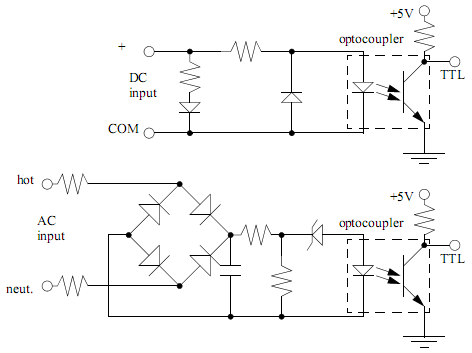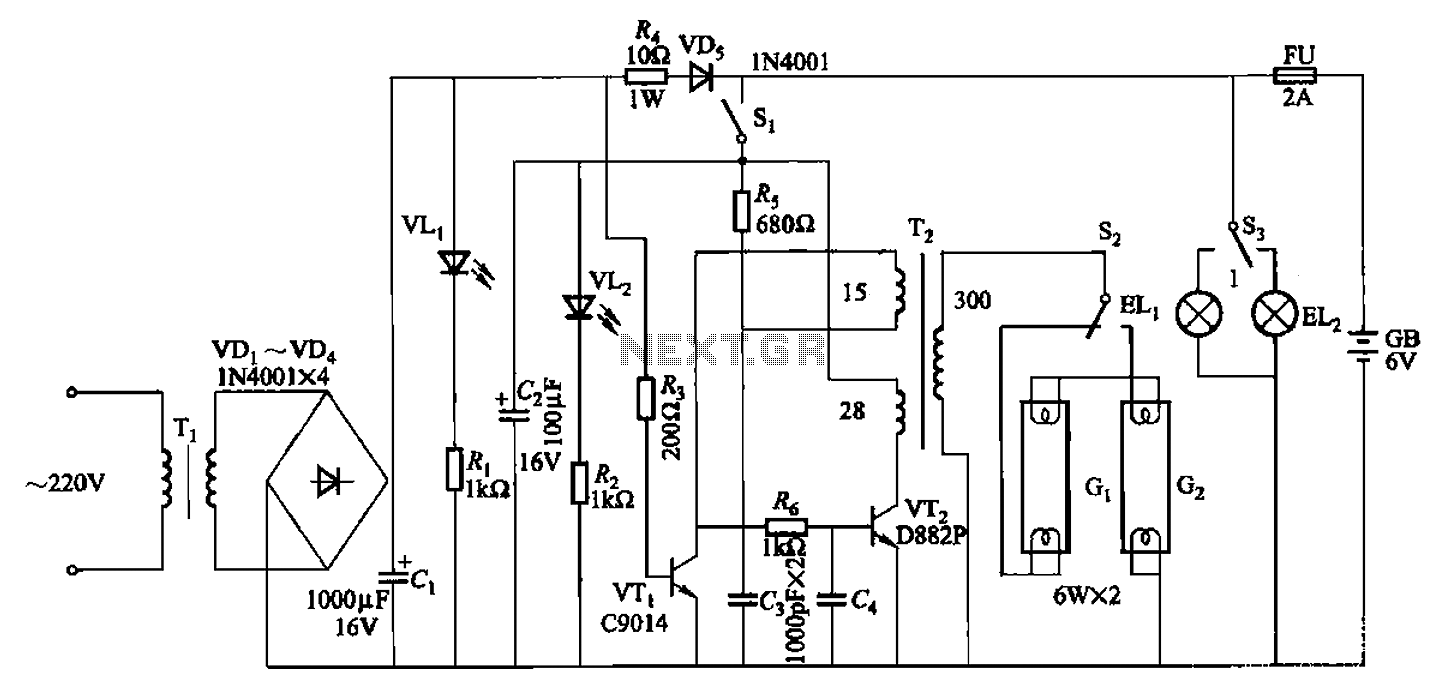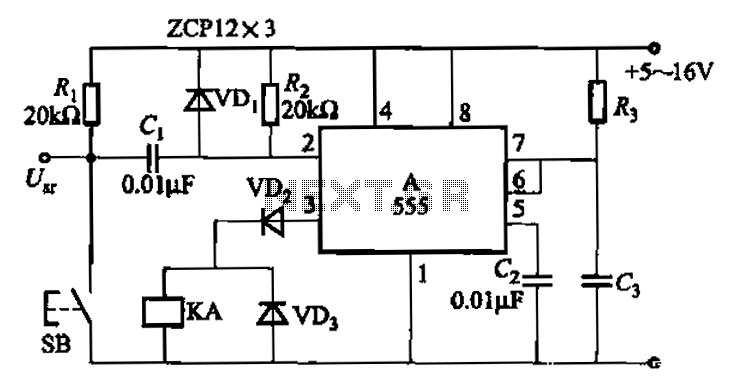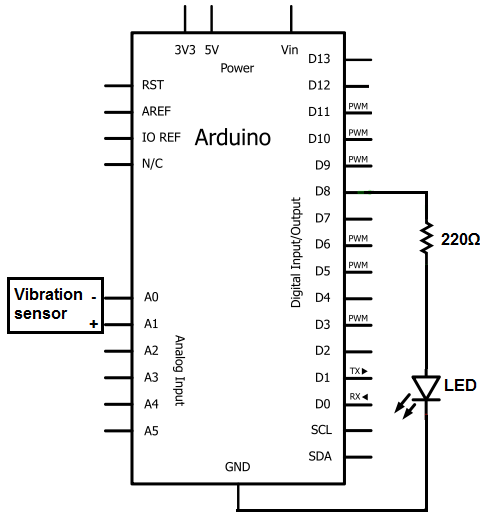
Cold-Cathode Fluorescent-Lamp Power Supply Circuit
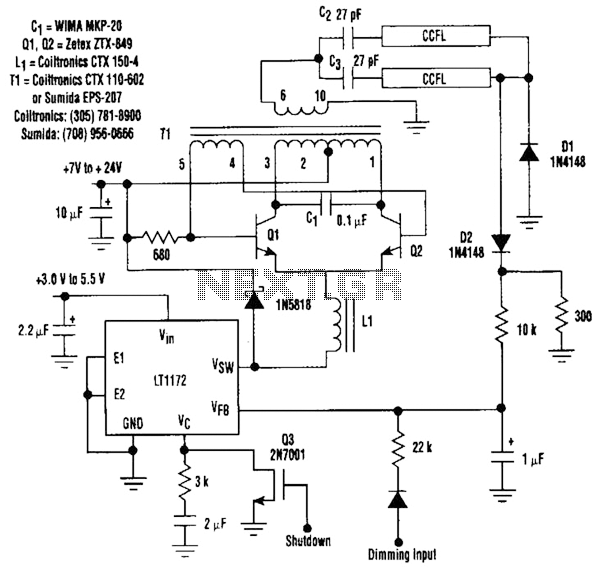
This circuit is a 92%-efficient power supply for cold-cathode fluorescent lamps (CCFLs), which are used to backlight LCDs in portable equipment. The efficiency depends heavily on the component types, particularly C1, Q1, Q2, L1, and T1, whose manufacturers are noted.
The described circuit operates as a high-efficiency power supply specifically designed for cold-cathode fluorescent lamps (CCFLs), which are commonly utilized for backlighting in various portable devices such as laptops, monitors, and other LCD-based equipment. The circuit achieves an efficiency rating of 92%, which is a critical factor in portable applications where battery life and power consumption are paramount.
Key components that significantly influence the performance of this power supply include capacitor C1, transistors Q1 and Q2, inductor L1, and transformer T1. Each of these components must be selected carefully from specific manufacturers to ensure optimal performance and reliability.
C1 serves as a filter capacitor, smoothing the output voltage and reducing ripple, which is essential for maintaining stable lamp operation. The choice of Q1 and Q2, typically high-frequency switching transistors, is crucial for achieving the desired efficiency and minimizing power loss during the switching process. L1 acts as an energy storage element, allowing for the conversion of input voltage to a higher output voltage required to drive the CCFLs. The transformer T1 plays a vital role in voltage step-up and isolation, ensuring that the output voltage is suitable for the CCFLs while providing safety from high voltages.
The circuit's design may also incorporate feedback mechanisms to regulate the output and maintain consistent brightness across varying input voltages. This feedback loop can be established using additional components such as operational amplifiers or dedicated control ICs, which monitor the output and adjust the switching frequency of Q1 and Q2 accordingly.
Overall, the efficiency of the circuit is not only a result of the individual component selection but also the overall design topology, which may include techniques such as resonant conversion or synchronous rectification to further enhance performance. The careful consideration of these factors ensures that the power supply meets the demands of modern portable devices while providing reliable and efficient backlighting for LCDs. This circuit is a 92%-efficient power supply for colrl-cathode fluorescent lamps (CCFLs), which are used to backlight LCD in portable equipment. The efficiency depends heavily on the component types, particularly Cl, Ql, Q2, LI, and Tl, whose manufacturers are noted.
The described circuit operates as a high-efficiency power supply specifically designed for cold-cathode fluorescent lamps (CCFLs), which are commonly utilized for backlighting in various portable devices such as laptops, monitors, and other LCD-based equipment. The circuit achieves an efficiency rating of 92%, which is a critical factor in portable applications where battery life and power consumption are paramount.
Key components that significantly influence the performance of this power supply include capacitor C1, transistors Q1 and Q2, inductor L1, and transformer T1. Each of these components must be selected carefully from specific manufacturers to ensure optimal performance and reliability.
C1 serves as a filter capacitor, smoothing the output voltage and reducing ripple, which is essential for maintaining stable lamp operation. The choice of Q1 and Q2, typically high-frequency switching transistors, is crucial for achieving the desired efficiency and minimizing power loss during the switching process. L1 acts as an energy storage element, allowing for the conversion of input voltage to a higher output voltage required to drive the CCFLs. The transformer T1 plays a vital role in voltage step-up and isolation, ensuring that the output voltage is suitable for the CCFLs while providing safety from high voltages.
The circuit's design may also incorporate feedback mechanisms to regulate the output and maintain consistent brightness across varying input voltages. This feedback loop can be established using additional components such as operational amplifiers or dedicated control ICs, which monitor the output and adjust the switching frequency of Q1 and Q2 accordingly.
Overall, the efficiency of the circuit is not only a result of the individual component selection but also the overall design topology, which may include techniques such as resonant conversion or synchronous rectification to further enhance performance. The careful consideration of these factors ensures that the power supply meets the demands of modern portable devices while providing reliable and efficient backlighting for LCDs. This circuit is a 92%-efficient power supply for colrl-cathode fluorescent lamps (CCFLs), which are used to backlight LCD in portable equipment. The efficiency depends heavily on the component types, particularly Cl, Ql, Q2, LI, and Tl, whose manufacturers are noted.
